September 25, 2008
Survival after emergency cardiac arrest treatment varies widely
An analysis of emergency medical services-treated cardiac arrest outcomes in 10 areas in North America finds a fivefold difference in survival rates, according to a study in the Sept. 24 issue of Journal of the American Medical Association.
Led by researchers at the UW, the study finds large differences in how often out-of-hospital cardiac arrest occurs, and how often people with cardiac arrest survive to be discharged home. The results are the first data to be published from a landmark series of studies, known as the Resuscitation Outcomes Consortium, designed to reveal the best life-saving techniques for cardiac and trauma emergencies.
The study included data on all out-of-hospital cardiac arrests in 10 North American sites (eight U.S. and two Canadian) from May 2006 to April 30, 2007, followed up to hospital discharge, and including data available as of June 28, 2008. Researchers closely monitored the circumstances surrounding more than 20,000 incidents of cardiac arrest called into 911 emergency telephone lines.
Cases were assessed by organized emergency medical services (EMS) personnel. The 10 sites were participants in the Resuscitation Outcomes Consortium and were located in: Alabama; Dallas; Iowa; Milwaukee; Ottawa, Ontario; Pittsburgh; Portland, Ore.; Seattle; Toronto; and Vancouver, British Columbia.
In the regions that participated in the study, there was more than 200 percent variation in how often cardiac arrest occurred. An average of 7.9 percent of patients with cardiac arrest who were treated by emergency medical technicians or paramedics were discharged home. Survival ranged from 3 percent to 16.3 percent, or more than 500 percent among the regions; 21 percent of those with ventricular fibrillation were discharged home. Survival ranged from 7.7 percent to 39.9 percent, or more than 500 percent among the regions.
“We were surprised by how large the differences were between regions,” said Dr. Graham Nichol, a physician at the UW-Harborview Medical Center for Prehospital Emergency Care in Seattle and principal author of the study.
“These differences reflect differences in patients’ risk of arrest, as well as the local approach to organized emergency response and care in hospital after resuscitation. This is a serious public health issue,” Nichol said. “Each community needs to examine how well it is treating cardiac arrest. It may get better results by training the public to recognize and respond to medical emergencies, by improving the local organized emergency response, or by improving hospital care for these patients.”
Among the 10 sites, with a total population of 21.4 million for the areas studied, there were 20,520 cardiac arrests assessed by EMS personnel. Resuscitation was attempted in 11,898 cases (58 percent of total); 2,729 (22.9 percent of treated) had initial rhythm of ventricular fibrillation or ventricular tachycardia (unstable, rapid heart rhythm) or rhythms that were shockable by an automated external defibrillator; and 954 (4.6 percent) were discharged alive. The incidence of EMS-treated cardiac arrest per 100,000 population ranged from 40.3 to 86.7; for ventricular fibrillation, the incidence per 100,000 population ranged from 9.3 to 19. The EMS-treated cardiac arrest survival across sites ranged from 3 percent to 16.3 percent; ventricular fibrillation survival ranged from 7.7 percent to 39.9 percent, with significant differences across sites for incidence and survival.
Approximately 166,000 to 310,000 Americans per year experience an out-of-hospital cardiac arrest, although resuscitation is not attempted in many of these cases.
The study findings show that out-of-hospital cardiac arrest is a treatable condition. They also support the need to require out-of-hospital cardiac arrest to be reported to public health groups so that each community can monitor and improve outcomes after cardiac arrest, Nichol said.
The study is set to continue through 2010 and is funded by the U.S. National Heart and Lung and Blood Institute, Canadian Institutes of Health Research, American Heart Association and other agencies.



